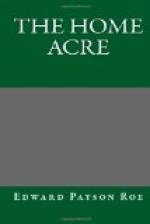CHAPTER VII
STRAWBERRIES
There is a very general impression that light, dry, sandy soils are the best for the strawberry. Just the reverse of this is true. In its desire for moisture it is almost an aquatic plant. Experienced horticulturists have learned to recognize this truth, which the Hon. Marshall P. Wilder has suggested in the following piquant manner: “In the first place, the strawberry’s chief need is a great deal of water. In the second place, it needs more water. In the third place, I think I should give it a great deal more water.”
While emphasizing this truth the reader should at the same time be warned against land whereon water stands above the surface in winter and spring, or stagnates beneath the surface at any time. Moisture is essential to the best results; good drainage is equally so. The marvellous crops of strawberries raised in California under well-directed systems of irrigation should teach us useful lessons. The plants, instead of producing a partially developed crop within a few brief days, continue in bearing through weeks and months. It may often be possible to supply abundantly on the Home Acre this vital requirement of moisture, and I shall refer to this point further on.
My first advice in regard to strawberries is to set them out immediately almost anywhere except upon land so recently in grass that the sod is still undecayed. This course is better than not to have the fruit at all, or to wait for it A year without strawberries is a lost year in one serious respect. While there is a wide difference between what plants can do under unfavorable conditions and what they can be made to do when their needs are fully met, they will probably in any event yield a fair supply of delicious fruit. Secure this as soon as possible. At the same time remember that a plant of a good variety is a genius capable of wonderful development. In ordinary circumstances it is like the “mute, inglorious” poets whose enforced limitations were lamented by the poet Gray; but when its innate powers and gifts are fully nourished it expands into surprising proportions, sends up hundreds of flowers, which are followed by ruby gems of fruit whose exquisite flavor is only surpassed by its beauty. No such concentrated ambrosia ever graced the feasts of the Olympian gods, for they were restricted to the humble Fragaria vesca, or Alpine species. In discovering the New World, Columbus also discovered the true strawberry, and died without the knowledge of this result of his achievement.
I can imagine the expression on the faces of those who buy the “sour, crude, half-ripe Wilsons,” against which the poet Bryant inveighed so justly. The market is flooded with this fruit because it bears transportation about as well as would marbles. Yes, they are strawberries; choke-pears and Seckels belong to the same species. There is truth enough in my exaggeration to warrant the assertion that if we would enjoy the possible strawberry, we must raise it ourselves, and pick it when fully matured—ready for the table, and not for market. Then any man’s garden can furnish something better than was found in Eden.




